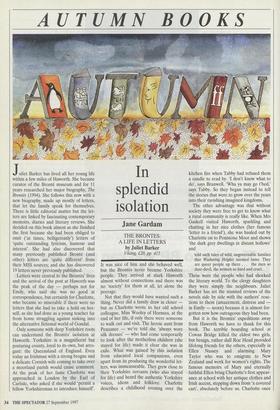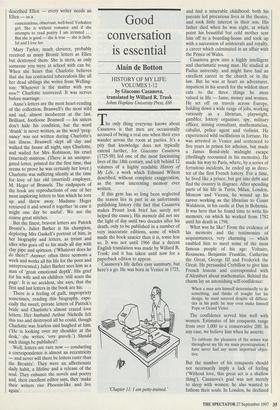AUTUMN BOOKS
In splendid isolation
Jane Gardam
THE BRONTES: A LIFE IN LEITERS by Juliet Barker Viking, 120, pp. 415 Juliet Barker has lived all her young life within a few miles of Haworth. She became curator of the Brontë museum and for 11 years researched her major biography, The Brontës (1994). She follows this now with a new biography, made up mostly of letters, that let the family speak for themselves. There is little editorial matter but the let- ters are linked by fascinating contemporary memoirs, diaries and literary reviews. She decided on this book almost as she finished the first because she had been obliged to omit Cat times, belligerently') letters of `quite outstanding lyricism, humour and interest'. She had also discovered that many previously published Brontë (and other) letters are 'quite different' from their MSS sources; and she has discovered 19 letters never previously published.
Letters were central to the Brontës' lives and the arrival of the post at Haworth was the peak of the day — perhaps not for Emily, who said she was no good at correspondence, but certainly for Charlotte, who became so miserable if there were no letters that she had to take a hold on her- self, as she had done as a young teacher far from home struggling against sinking into the alternative fictional world of Gondal.
Only someone with deep Yorkshire roots can understand the Brontës' isolation at Haworth. Yorkshire is a magnificent but posturing county, loyal to its own, but arro- gant: the Queensland of England. Even today an Irishman with a strong brogue and a delicate Cornish wife coming to take over a moorland parish would cause comment. At the peak of her fame Charlotte was approached in London by the Earl of Carlisle, who asked if she would 'permit a fellow Yorkshireman to introduce himself. It was nice of him and she behaved well, but the Brontës never became Yorkshire people. They arrived at stark Haworth almost without connections and there was no 'society' for them at all, let alone the peerage. Not that they would have wanted such a thing. Never did a family draw in closer but as Charlotte wrote to her old school colleague, Miss Wooley of Hornsea, at the end of her life, if only there were someone to walk out and visit. The heroic aunt from Penzance — we're told she 'always wore silk dresses' — who had come temporarily to look after the motherless children (she stayed for life) made it clear she was in exile. What was gained by this isolation from educated local companions, even apart from its producing the wonderful let- ters, was immeasurable. They grew close to their Yorkshire servants (who also stayed for life) and heard the authentic Yorkshire voices, idiom and folklore. Charlotte describes a childhood evening over the kitchen fire when Tabby had refused them a candle to read by. 'I don't know what to do', says Branwell. `Wha ya may go t'bed,' says Tabby. So they began instead to tell the stories that were .to grow over the years into their ravishing imagined kingdoms.
The other advantage was that without society they were free to get to know what a rural community is really like. When Mrs Gaskell visited Haworth, sparkling and chatting in her nice clothes (her famous `letter to a friend'), she was hauled out by Charlotte on to Penistone Moor and shown `the dark grey dwellings in distant hollows' and
told such tales of wild, ungovernable families that Wuthering Heights seemed tame. They are queer people up there . . . the men so dare-devil, the women so hard and cruel. These were the people who had shocked the literary world. To the clergy daughters they were simply the neighbours. Juliet Barker has set the stunned reviews of the novels side by side with the authors' reac- tions to them (amazement, distress and in Emily — scorn) because it is almost for- gotten now how outrageous they had been.
But it is the Brontës' expeditions away from Haworth we have to thank for this book. The terrible boarding school at Cowan Bridge killed the eldest two girls, but benign, rather dull Roe Head provided lifelong friends for the others, especially in Ellen Nussey and alarming Mary Taylor who was to emigrate to New Zealand and work for women's rights. The famous memoirs of Mary and eternally faithful Ellen bring Charlotte's first appear- ance at school with her antique clothes and Irish accent, stepping down from 'a covered cart', absolutely before us. Charlotte once described Ellen — every writer needs an Ellen — as a conscientious, observant, well-bred Yorkshire girl. She is without romance and if she attempts to read poetry I am irritated . • . But she is good — she is true — she is faith- ful and I love her.
Mary Taylor, much cleverer, probably received as many Brontd letters as Ellen but destroyed them. She is stern, as only someone you were at school with can be. When she hears that Charlotte believes that she has contracted tuberculosis like all her dead siblings she writes from Welling- ton: 'Whatever is the matter with you now?' Charlotte recovered. It was nerves before marriage.
Anne's letters are the most heart-rending of the collection, Branwell's the most wild and sad, almost incoherent at the last. Brilliant, footloose Branwell — his sisters don't hide his condition, but the word `drunk' is never written, as the word 'preg- nancy' was not written during Charlotte's last illness. Branwell slept all day and walked the house all night, says Charlotte, and wailed for Mrs Robinson, his cruel (married) mistress. (There is an unexpur- gated letter, printed for the first time, that seems to prove he was certainly her lover.) Charlotte was suffering silently at the time for love of her old (married) employer, M. Heger of Brussels. The endpapers of the book are reproductions of one of her most imploring letters to him which he tore up and threw away. Madame Heger retrieved it and sewed it together 'in case it might one day be useful'. We see the coarse great stitches. But the finest, bravest letters are Patrick Bronte's. Juliet Barker is his champion, deploring Mrs Gaskell's portrait of him, in her biography and letters, as tyrant and idler who goes off to his study all day with clay pipe and spittoon. ('Whatever does he do there?' Answer: often three sermons a week and works all his life for the poor and unrepresented.) Juliet Barker sees him as a man of 'great emotional depth'. His grief for his wife and six children 'still sears the page'. It is no accident, she says, that the first and last letters in the book are his.
There is a feeling of guilt, impropriety sometimes, reading this biography, espe- cially the sweet, private letters of Patrick's bride and Charlotte's almost crazed love letters. Her husband Arthur Nicholls felt this too and destroyed all he could, though Charlotte was fearless and laughed at him. (Ile is looking over my shoulder at the desk,' she writes, 'very gravely.') Should such things be published? Well, letters are rare now — conducting a correspondence is almost an eccentricity — and never will there be letters rarer than the Brontës'. They were an affectionate daily habit, a lifeline and a release of the soul. They enhance the novels and poetry and, their excellent editor says, they 'make their writers rise Phoenix-like and live again'.











































































 Previous page
Previous page